The principle of operation of the accumulator and why it is needed accumulator in the water supply system
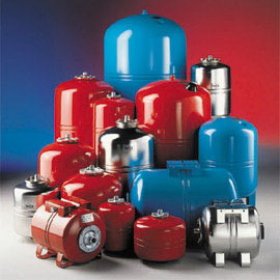
A hydraulic accumulator, it is also a storage, pressure or expansion tank - a necessary element for a closed water supply system in any private house. To correctly select and use such a drive, it does not hurt to study the principle of the accumulator, the types, causes of breakdowns and how to eliminate them. In addition, it does not hurt to figure out how the tanks of red and blue are different.
Content
How is the accumulator arranged and working?
Accumulators are often called membrane tanks, since inside of such a device there is a special rubber gasket - a membrane. It divides the container into two parts. On one side of the membrane is water, on the other - air or inter-gas. Also, the tank is usually equipped with a water inlet and a pressure gauge that reflects air pressure.
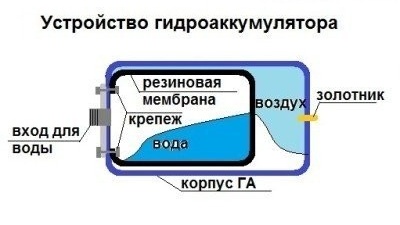
Typically, a hydraulic tank consists of a metal body and a rubber membrane. In addition, a spool regulating the air supply-bleed is installed, as well as a filter to remove small impurities
Water is supplied to the water supply system using a pump and pumped into the tank. As a result, the gas pressure in the accumulator with automation increases. When it reaches the maximum permissible value, the automatic control system turns off the pump and the water supply stops.
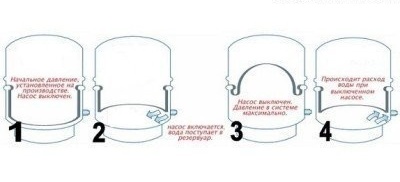
The diagram illustrates the principle of operation of a hydraulic tank in a water supply system. The device is controlled by automation, which increases its life
Gradually, water from the tank is consumed. The pressure decreases, reaches the minimum set limit, after which the automatic control system turns on the pump. Water enters the tank until the pressure reaches the set value, the pump shuts off, etc.
Our recommendations on choosing a pumping station for water supply at home are also useful to you:https://aquatech.tomathouse.com/en/vodosnab/nasos/nasos-stancii/kak-vybrat-nasosnuyu-stanciyu-dlya-doma-i-dachi-poleznye-sovety.html.
Why is such a drive necessary?
In the presence of a hydraulic tank, a pump on / off cycle occurs only when it is necessary to fill the tank with a sufficient supply of water. If there was no accumulator, the pump would turn on every time one of the households opens the tap. The presence of a storage tank in the system allows:
- significantly increase the life of the well pump;
- to prevent harm from possible water hammer in the system;
- maintain a certain pressure in the system;
- prevent breakdowns of elements of the water supply system and plumbing equipment.
Obviously, hydraulic accumulators for closed water supply are simply necessary. The role of the storage tank in the water supply system is described in detail in the following video:
Types of membrane tanks and their features
Distinguish between vertical and horizontal hydraulic tanks, which are differently mounted at the installation site. There is another important point. In the part of the tank that contains water, a small amount of air can accumulate over time. This air should be periodically removed to prevent air traffic jams that are quite dangerous for it from entering the system. In vertical containers, air accumulates at the top and a special nipple is used to discharge it.
With horizontal hydraulic tanks, everything is somewhat more complicated. To bleed the accumulated air here, you will need not only a nipple, but also a ball valve, as well as a sewer drain.
Owners of small hydraulic tanks, whose capacity is less than 100 liters, need to get rid of excess air otherwise. To do this:
- Turn off the power.
- Open the tap of the mixer.
- Wait until the tank is empty.
- Shut off valve.
- Connect the system to power so that the tank is full again.
Excess air will come out with water. This procedure should be done at least once a month.
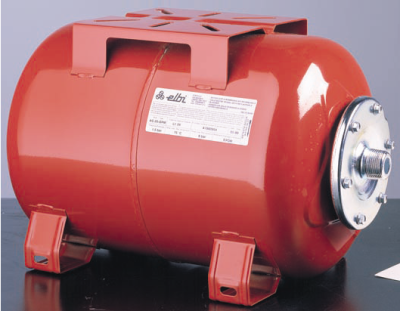
Red tanks are designed for hot water systems. Although the membrane in them is made of fairly strong rubber, they should not be used to supply cold water
Manufacturers offer red and blue hydraulic tanks, as well as colorless ones. Blue devices are intended for use in a cold water supply system. For the manufacture of membranes in such tanks use food rubber that is safe for human health. Red tanks are designed for heating and hot water. It is not recommended to use them for cold water, since the membrane in such tanks is made of other rubber. In addition, the operating pressure threshold for blue tank is higher and reaches 8 Bar.
Typically, water enters the reservoir from below, and above, as already noted, is a nipple through which air is vented. Therefore, each device has two threaded connections (usually inch or half inch) that should not be confused. An automatic device for venting air is often mounted on the upper nipple.
Sometimes there are situations when water is supplied to the hydraulic tank from above. It is believed that in this case, automatic air exhaust is not needed. But you should take care of the filter so that particles of sand or other contaminants do not get into the system.
Note! The consumer is offered the most diverse models of hydraulic tanks of foreign and domestic production. Not all imported devices are adapted for the Russian water supply system, which significantly reduces the time for their smooth operation. As practice has shown, domestic high-quality hydraulic tanks last longer.
Pay attention to the material about the device and the principles of operation of pumping stations:https://aquatech.tomathouse.com/en/vodosnab/nasos/nasos-stancii/ustrojstvo-i-princip-raboty-nasosnoj-stancii.html
Causes of breakdowns and solutions
The most vulnerable part of the tank is the rubber membrane. During operation, it is constantly subjected to stretching, and then contracts. Gradually, the rubber loses its elasticity and breaks. The following symptoms may indicate the occurrence of problems with the hydraulic tank:
water comes from the system in small portions at high pressure, the tap seems to “spit” with water;
the gauge needle sharply reaches large values and then immediately drops to zero.
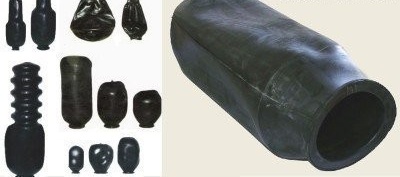
Rubber membranes for hydraulic tanks can have various shapes and sizes. When replacing the diaphragm, use a product designed for the specific tank model.
To make sure that the membrane is torn, it is necessary to press the nipple spool to let out air from the storage tank and determine what air pressure is in the accumulator.If at the same time the pressure gauge’s arrow immediately goes down, then there is very little air left in the hydraulic tank that provides the necessary pressure. It is necessary to completely bleed air, if after that water flows from the spool, then the membrane is definitely torn, repair is needed. If the water does not go, the membrane is intact, and the air leaves the tank through the cracks, faulty connections or spool.
Problems with the hydraulic tank in the hot water supply system may be indicated by a small leak that appears at the safety valve of the water heater. Proceed in exactly the same way: press the nipple of the zolotnitok, estimate the amount of air, bleed it completely and determine by the presence or absence of water whether the tank’s membrane is intact.
Replacing the membrane in the hydraulic tank is not so difficult, in addition, it is much cheaper than installing a new device. For repair you will need:
- Purchase a new membrane that matches the torn membrane.
- Carefully disassemble the hydraulic tank by unscrewing the connecting bolts.
- Remove the torn membrane.
- Install a new membrane in its place.
- Collect the hydraulic tank.
- Tighten all bolts evenly.
The main danger in this case is that inept handling of the device can lead to slipping of the edge of the membrane into the metal housing. As a result, the work will have to be redone. To avoid this, it is recommended to tighten the connecting bolts gradually to ensure uniform tension of the membrane. Problems arise when one bolt is fully tightened and only after that they begin to work with the next. The edge of the membrane is shifted and may slip.
You will learn about common faults and how to fix them in our material:https://aquatech.tomathouse.com/en/vodosnab/nasos/nasos-stancii/remont-nasosnoj-stancii-svoimi-rukami.html
Another mistake is the use of sealant at the joints. The use of such compositions reduces friction between rubber and metal. As a result, the edge of the membrane shifts, and the density of the compound decreases, which may cause water leakage in the future.

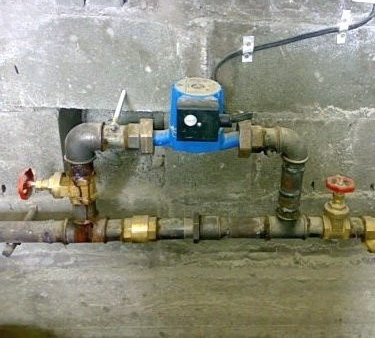
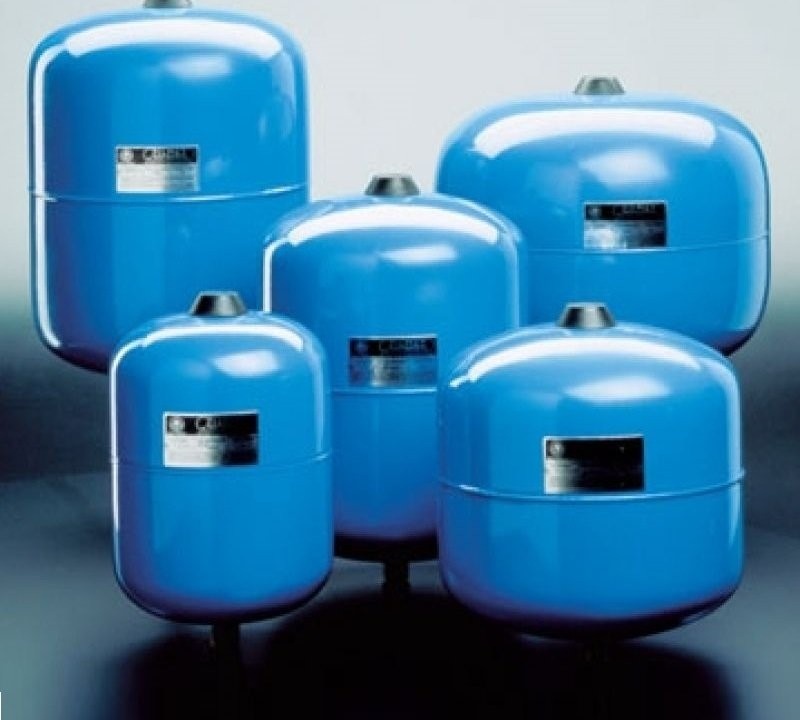
4 comments